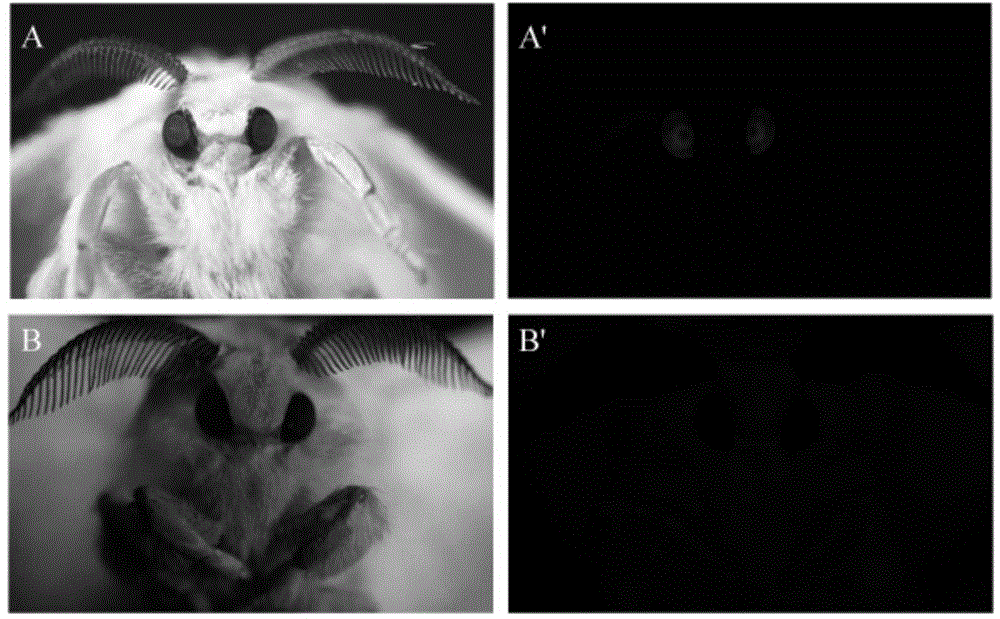Target sequence suitable for transgene fixed point insertion of silkworm W-chromosome and locus and application thereof
A technology for target sequences and chromosomes, applied in the field of nucleotide sequences, can solve problems such as the difficulty of W chromosome sequences, and achieve the effects of ensuring hybridization rate, avoiding losses and saving production costs.
- Summary
- Abstract
- Description
- Claims
- Application Information
AI Technical Summary
Problems solved by technology
Method used
Image
Examples
Embodiment 1
[0023] Embodiment 1, transgenic microinjection and screening of female-specific transgenic silkworm W-T
[0024] Silkworm eggs of silkworm "Dazao" and "P50" were soaked in acid for 5 minutes at a temperature of 46°C to remove diapause. The greening is accelerated in the environment for about 30 days until hatching. After hatching, the ant silkworms are collected and raised under the standard conditions of temperature 25°C and humidity 80%. Silkworm eggs were non-diapause silkworm eggs, which were used for microinjection in the next step.
[0025] Arrange the laid silkworm eggs on a clean glass slide, and inject the piggyBac [3×p3 EGFP afm] transgene vector and the auxiliary plasmid A3H into 5300 silkworm eggs with an Eppendorf microinjector 2 hours after laying the silkworm eggs In the process, seal the seal with non-toxic glue and place it in an environment of 25°C and 80% relative humidity to hatch for about 10 days. The hatched G0 generation ant silkworms are collected and...
Embodiment 2
[0027] Example 2, copy number detection of transgenic system W-T
[0028] Primers were designed for the GFP mutant line EGFP and the silkworm internal reference gene GAPDH (BmGAPDH). The forward primer of EGFP was 5'-gtgagcaagggcgaggagct-3' (SEQ ID NO.1), and the reverse primer was 5'-cttgtacagctcgtccatgcc-3' (SEQ ID NO.2); the forward primer of BmGAPDH is 5'-cattccgcgtccctgttgctaat-3' (SEQ ID NO.3), and the reverse primer is 5'-gctgcctccttgaccttttgc-3' (SEQ ID NO.4). The genomes of W-T female silkworm (W-T♀), W-T male silkworm (W-T♂), non-transgenic female silkworm (NT♀) and non-transgenic male silkworm (NT♂) were extracted and used as templates for PCR amplification. The PCR reaction conditions for amplifying the BmGAPDH gene are: 94°C pre-denaturation for 4 minutes, followed by 94°C denaturation for 40 seconds, 58°C annealing for 40 seconds, 72°C extension for 10 seconds, a total of 25 cycles, and finally 72°C extension for 10 minutes; The PCR reaction conditions of EGFP w...
Embodiment 3
[0030] Example 3 Insertion site detection of transgenic system W-T
[0031] The genome of W-T♀ was thoroughly digested with Hae III and self-ligated, and then amplified by inverse PCR using transposon-specific primers pBacL and pBacR. pBacR is used to amplify the partial sequence of the right arm (PR) of piggyBac[3×p3EGFP afm] and the adjacent genomic sequence (SG-R). The pBacR primer sequence is as follows, pBacR F; NO.5); pBacR R: 5'-gtactgtcatctgatgtaccagg-3' (SEQ ID NO.6), pBacL was used to amplify the partial sequence of the left arm (PL) of piggyBac[3×p3EGFP afm] and the adjacent genome sequence (SG -L), the pBacL primer sequence is as follows, pBacL F: 5'-atcagtgacacttaccgcattgaca-3' (SEQ ID NO.7), pBacL R: 5'-tgacgagcttgttggtgaggattct-3' (SEQ ID NO.8), the position is as follows image 3 As shown in A. The PCR product was identified and recovered by agarose gel electrophoresis, and then ligated with pMD19-T vector. The ligation reaction was performed under the action...
PUM
 Login to View More
Login to View More Abstract
Description
Claims
Application Information
 Login to View More
Login to View More - R&D
- Intellectual Property
- Life Sciences
- Materials
- Tech Scout
- Unparalleled Data Quality
- Higher Quality Content
- 60% Fewer Hallucinations
Browse by: Latest US Patents, China's latest patents, Technical Efficacy Thesaurus, Application Domain, Technology Topic, Popular Technical Reports.
© 2025 PatSnap. All rights reserved.Legal|Privacy policy|Modern Slavery Act Transparency Statement|Sitemap|About US| Contact US: help@patsnap.com



